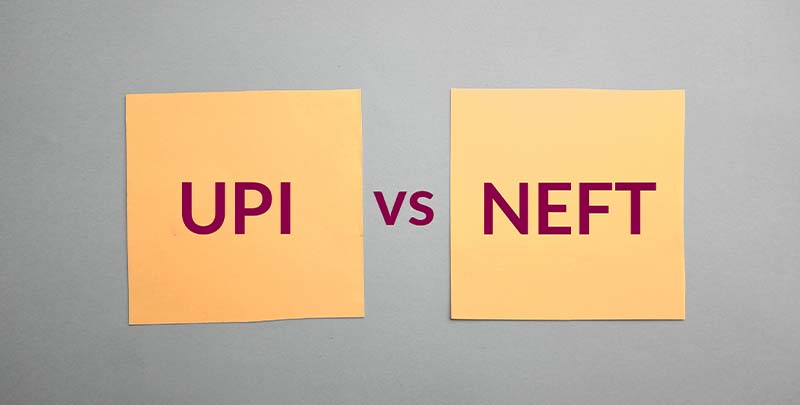Electronic fund transfers are essential for seamless financial transactions. Two popular methods in India are UPI (Unified Payments Interface) and NEFT (National Electronic Funds Transfer). Understanding the NEFT vs UPI comparison can help you choose the best option for your financial needs, based on speed, convenience, and transaction limits.
Key differences between NEFT vs UPI
| Criteria |
NEFT |
UPI |
|---|
| Platform |
Operates via bank branches or online banking. |
Operates through mobile apps linked to bank accounts. |
| Time of transfer |
Batch processing during bank hours (8 AM - 7 PM). |
Instant, 24/7 transfers, including holidays. |
| Transfer type |
Only bank-to-bank transfers. |
Bank-to-bank and P2P transfers. |
| Cost of transfer |
Nominal charges, often free for under ₹2 lakh. |
Mostly free with no additional costs. |
| Beneficiary details |
Requires account number and IFSC. |
Uses UPI ID or mobile number. |
| Transaction limit |
No official limit, varies by bank. |
₹1 lakh per day (varies by bank). |
| Bank account requirement |
Both sender and receiver need bank accounts. |
Only the sender needs a bank account. |
| Ease of use |
Requires internet banking, less mobile-friendly. |
Highly user-friendly, mobile-based. |
| Security |
Secure with two-step verification. |
Real-time encryption with high security. |
List of 10 key benefits of UPI
Unified Payments Interface (UPI) has revolutionised digital payments in India with its convenience and efficiency. Here are 10 key benefits of using UPI:
- Enables quick, seamless transfers 24/7 for personal and business transactions.
- Offers single-click two-factor authentication for secure payments.
- Transactions use a UPI ID or Virtual Payment Address (VPA), avoiding the need for sharing bank details.
- Link multiple bank accounts in one app, eliminating the need for different banking apps.
- Facilitates easy payments via QR codes for both online and offline transactions.
- Eliminates the need to carry cash or visit ATMs with all payments handled digitally.
- Allows payment collection through a convenient 'collect' request feature.
- Settles funds instantly in real-time, ensuring quick receipt of payments.
- Accepted by a wide network of merchants for everyday transactions.
- Lets users raise and resolve complaints directly from the app.
List of 10 key benefits of NEFT
NEFT remains a robust option for specific banking needs, particularly for large, scheduled transactions. Here are 10 key benefits:
- Accepted by all banks in India, making it widely accessible for transfers.
- No maximum transaction limit, suitable for large-value transfers.
- Allows scheduling of payments for bills or recurring needs.
- Available both online and offline, offering flexibility in transfer methods.
- Transactions are monitored and regulated by the RBI, ensuring high security.
- Processes transfers in hourly batches, ensuring smooth operations.
- Supports foreign remittances directly to beneficiary accounts.
- Nominal transfer charges, especially for smaller transactions.
- Provides detailed transaction records for easy tracking.
- Favoured for reliable business-to-business (B2B) payments.
Conclusion
UPI is ideal for quick, small transactions, while NEFT suits large, scheduled transfers. Understanding NEFT vs UPI helps you make smarter financial decisions. Leverage Axis Bank's solutions for seamless, secure, and cost-effective transactions.
Also Read: How to transfer money through UPI?
FAQs
Is NEFT online or offline?
NEFT can be done both online via internet banking and offline at bank branches.
Is GPay NEFT?
No, GPay operates through UPI, not NEFT.
How can one check the status of a UPI or NEFT transaction?
Check UPI status via the app or NEFT status through internet banking or branch inquiry.
Is NEFT free?
NEFT is free for transactions up to ₹2 lakh, with nominal charges for higher amounts.
Disclaimer: This article is for information purpose only. The views expressed in this article are personal and do not necessarily constitute the views of Axis Bank Ltd. and its employees. Axis Bank Ltd. and/or the author shall not be responsible for any direct / indirect loss or liability incurred by the reader for taking any financial decisions based on the contents and information. Please consult your financial advisor before making any financial decision.







